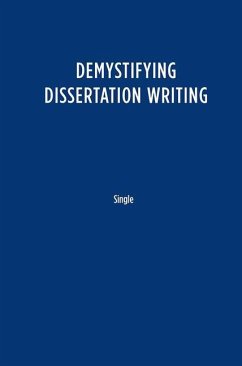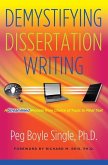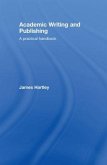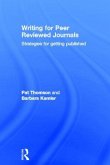Peg Boyle Single
Demystifying Dissertation Writing
A Streamlined Process from Choice of Topic to Final Text
Peg Boyle Single
Demystifying Dissertation Writing
A Streamlined Process from Choice of Topic to Final Text
- Gebundenes Buch
- Merkliste
- Auf die Merkliste
- Bewerten Bewerten
- Teilen
- Produkt teilen
- Produkterinnerung
- Produkterinnerung
This book presents a system of straightforward and proven techniques that are used by productive writers, and applies them to the dissertation process. This book is intended for graduate students and their advisers in the social sciences, the humanities, and professional fields.
Andere Kunden interessierten sich auch für
![Demystifying Dissertation Writing Demystifying Dissertation Writing]() Peg Boyle SingleDemystifying Dissertation Writing40,99 €
Peg Boyle SingleDemystifying Dissertation Writing40,99 €![The Qualitative Dissertation in Education The Qualitative Dissertation in Education]() Karri A HolleyThe Qualitative Dissertation in Education180,99 €
Karri A HolleyThe Qualitative Dissertation in Education180,99 €![Writing Research Critically Writing Research Critically]() John SchostakWriting Research Critically180,99 €
John SchostakWriting Research Critically180,99 €![Detox Your Writing Detox Your Writing]() Pat ThomsonDetox Your Writing203,99 €
Pat ThomsonDetox Your Writing203,99 €![Academic Writing and Publishing Academic Writing and Publishing]() James HartleyAcademic Writing and Publishing200,99 €
James HartleyAcademic Writing and Publishing200,99 €![Helping Doctoral Students Write Helping Doctoral Students Write]() Barbara KamlerHelping Doctoral Students Write200,99 €
Barbara KamlerHelping Doctoral Students Write200,99 €![Writing for Peer Reviewed Journals Writing for Peer Reviewed Journals]() Pat ThomsonWriting for Peer Reviewed Journals202,99 €
Pat ThomsonWriting for Peer Reviewed Journals202,99 €-
-
-
This book presents a system of straightforward and proven techniques that are used by productive writers, and applies them to the dissertation process. This book is intended for graduate students and their advisers in the social sciences, the humanities, and professional fields.
Hinweis: Dieser Artikel kann nur an eine deutsche Lieferadresse ausgeliefert werden.
Hinweis: Dieser Artikel kann nur an eine deutsche Lieferadresse ausgeliefert werden.
Produktdetails
- Produktdetails
- Verlag: Taylor & Francis
- Seitenzahl: 192
- Erscheinungstermin: 28. September 2009
- Englisch
- Abmessung: 231mm x 152mm x 23mm
- Gewicht: 499g
- ISBN-13: 9781579223120
- ISBN-10: 1579223125
- Artikelnr.: 26852901
- Herstellerkennzeichnung
- Libri GmbH
- Europaallee 1
- 36244 Bad Hersfeld
- 06621 890
- Verlag: Taylor & Francis
- Seitenzahl: 192
- Erscheinungstermin: 28. September 2009
- Englisch
- Abmessung: 231mm x 152mm x 23mm
- Gewicht: 499g
- ISBN-13: 9781579223120
- ISBN-10: 1579223125
- Artikelnr.: 26852901
- Herstellerkennzeichnung
- Libri GmbH
- Europaallee 1
- 36244 Bad Hersfeld
- 06621 890
Peg Boyle Single is an academic writing coach who works with doctoral students and faculty members, and a consultant who offers workshops on writing and mentoring programs. She and has been conducting writing seminars and providing writing coaching for over 15 years. Prior to becoming an independent consultant, she was Director of the Faculty Mentoring Program and a Research Associate Professor at the University of Vermont. Richard M. Reis is the Executive Director of the Alliance for Innovative Manufacturing (AIM) at Stanford and Co-Exeuctive Director of the Stanford Research Communication Program. A Lecturer in the Stanford Mechanical Engineering department, he teaches an introductory seminar for all incoming Electrical Engineering graduate students. He is also editor of the Tomorrow's Professor eNewsletter.
1 The Single System for Academic Writing 1.1. Developing Habits of Fluent
Writing 1.2. Using Demystifying Dissertation Writing as a Guide for Writing
Groups and Seminars 1.3. Data on Ph.D. Completion Rates 1.4. The Single
System and Prewriting 1.5. Keeping Perspective on Your Dissertation Project
2 Choosing a Topic and an Adviser 2.1. A Set of Constraints 2.2. Choosing a
Dissertation Topic and an Adviser 2.3. Additional Constraints to Consider
2.4. Entering the Conversation: Subject Matter 2.5. Examples of
Dissertation Topics 2.6. Entering the Conversation: Theories and Methods
2.7. Managing Your Adviser and Your Dissertation Committee Members 2.8.
Group Exercises for Choosing a Topic and an Adviser 3 Interactive Reading
and Note Taking 3.1. Scholarly Reading Is the Foundation of Your
Dissertation 3.2. Reading Is a Privilege 3.3. Collect Notes, Not Articles
or Books 3.4. Interactive Reading in Practice3.5. Using a Bibliographic
Program to Record Interactive Notes 3.6. Rules for Recording Quotations
3.7. Plagiarism and Copyright Infringement 3.8. Group Exercises for
Interactive Reading and Note Taking 4 Citeable Notes 4.1. Recording
Citeable Notes and Building Your Literature Review 4.2. Group Exercises for
Creating Citeable Notes and Identifying Categories 5 Focusing on Focus
Statements 5.1. Useful Focus Statements Are Clear, Concise, and Compelling
5.2. Elements of a Useful Focus Statement 5.3. Providing Useful Feedback
5.4. Group Exercises That Focus on Focus Statements 6 Transforming a Focus
Statement Into a One-Page Outline 6.1. The Role and Elements of the
One-Page Outline 6.2. Formats for the Dissertation 6.3. Group Exercises
That Transform Focus Statements Into One-Page Outlines 6.4. Using the Table
of Contents Feature as an Efficiency Tool 7 Long Outline With References
7.1. Multiple Purposes of the Long Outline 7.2. Transforming a One-Page
Outline Into a Long Outline 7.3. Inserting Citeable Notes Into Your Long
Outline 7.4. Planning and Organizing Your Scholarship and Research 7.5.
Getting a Format Check by Your Graduate College 7.6. A Group Exercise for
Sharing and Reviewing Long Outlines With References 8 Developing a Regular
Writing Routine 8.1. A Regular Writing Routine 8.2. The Importance of a
Designated Writing Space 8.3. Developing a Writing Network 8.4. What a
Regular Writing Routine Looks Like in Practice 8.5. Group Exercises for
Establishing a Regular Writing Routine 9 Overcoming Writer's Block 9.1.
Perfectionism 9.2. Procrastination 9.3. Impatience 9.4. Depression and
Dysphoria 9.5. Group Exercises for Overcoming Writer's Block 10 The Role of
Revision 10.1. Revision at the Organizational Level 10.2. Revision at the
Content Level 10.3. Group Exercises for Revision Epilogue and Enjoying the
Journey
Writing 1.2. Using Demystifying Dissertation Writing as a Guide for Writing
Groups and Seminars 1.3. Data on Ph.D. Completion Rates 1.4. The Single
System and Prewriting 1.5. Keeping Perspective on Your Dissertation Project
2 Choosing a Topic and an Adviser 2.1. A Set of Constraints 2.2. Choosing a
Dissertation Topic and an Adviser 2.3. Additional Constraints to Consider
2.4. Entering the Conversation: Subject Matter 2.5. Examples of
Dissertation Topics 2.6. Entering the Conversation: Theories and Methods
2.7. Managing Your Adviser and Your Dissertation Committee Members 2.8.
Group Exercises for Choosing a Topic and an Adviser 3 Interactive Reading
and Note Taking 3.1. Scholarly Reading Is the Foundation of Your
Dissertation 3.2. Reading Is a Privilege 3.3. Collect Notes, Not Articles
or Books 3.4. Interactive Reading in Practice3.5. Using a Bibliographic
Program to Record Interactive Notes 3.6. Rules for Recording Quotations
3.7. Plagiarism and Copyright Infringement 3.8. Group Exercises for
Interactive Reading and Note Taking 4 Citeable Notes 4.1. Recording
Citeable Notes and Building Your Literature Review 4.2. Group Exercises for
Creating Citeable Notes and Identifying Categories 5 Focusing on Focus
Statements 5.1. Useful Focus Statements Are Clear, Concise, and Compelling
5.2. Elements of a Useful Focus Statement 5.3. Providing Useful Feedback
5.4. Group Exercises That Focus on Focus Statements 6 Transforming a Focus
Statement Into a One-Page Outline 6.1. The Role and Elements of the
One-Page Outline 6.2. Formats for the Dissertation 6.3. Group Exercises
That Transform Focus Statements Into One-Page Outlines 6.4. Using the Table
of Contents Feature as an Efficiency Tool 7 Long Outline With References
7.1. Multiple Purposes of the Long Outline 7.2. Transforming a One-Page
Outline Into a Long Outline 7.3. Inserting Citeable Notes Into Your Long
Outline 7.4. Planning and Organizing Your Scholarship and Research 7.5.
Getting a Format Check by Your Graduate College 7.6. A Group Exercise for
Sharing and Reviewing Long Outlines With References 8 Developing a Regular
Writing Routine 8.1. A Regular Writing Routine 8.2. The Importance of a
Designated Writing Space 8.3. Developing a Writing Network 8.4. What a
Regular Writing Routine Looks Like in Practice 8.5. Group Exercises for
Establishing a Regular Writing Routine 9 Overcoming Writer's Block 9.1.
Perfectionism 9.2. Procrastination 9.3. Impatience 9.4. Depression and
Dysphoria 9.5. Group Exercises for Overcoming Writer's Block 10 The Role of
Revision 10.1. Revision at the Organizational Level 10.2. Revision at the
Content Level 10.3. Group Exercises for Revision Epilogue and Enjoying the
Journey
1 The Single System for Academic Writing 1.1. Developing Habits of Fluent
Writing 1.2. Using Demystifying Dissertation Writing as a Guide for Writing
Groups and Seminars 1.3. Data on Ph.D. Completion Rates 1.4. The Single
System and Prewriting 1.5. Keeping Perspective on Your Dissertation Project
2 Choosing a Topic and an Adviser 2.1. A Set of Constraints 2.2. Choosing a
Dissertation Topic and an Adviser 2.3. Additional Constraints to Consider
2.4. Entering the Conversation: Subject Matter 2.5. Examples of
Dissertation Topics 2.6. Entering the Conversation: Theories and Methods
2.7. Managing Your Adviser and Your Dissertation Committee Members 2.8.
Group Exercises for Choosing a Topic and an Adviser 3 Interactive Reading
and Note Taking 3.1. Scholarly Reading Is the Foundation of Your
Dissertation 3.2. Reading Is a Privilege 3.3. Collect Notes, Not Articles
or Books 3.4. Interactive Reading in Practice3.5. Using a Bibliographic
Program to Record Interactive Notes 3.6. Rules for Recording Quotations
3.7. Plagiarism and Copyright Infringement 3.8. Group Exercises for
Interactive Reading and Note Taking 4 Citeable Notes 4.1. Recording
Citeable Notes and Building Your Literature Review 4.2. Group Exercises for
Creating Citeable Notes and Identifying Categories 5 Focusing on Focus
Statements 5.1. Useful Focus Statements Are Clear, Concise, and Compelling
5.2. Elements of a Useful Focus Statement 5.3. Providing Useful Feedback
5.4. Group Exercises That Focus on Focus Statements 6 Transforming a Focus
Statement Into a One-Page Outline 6.1. The Role and Elements of the
One-Page Outline 6.2. Formats for the Dissertation 6.3. Group Exercises
That Transform Focus Statements Into One-Page Outlines 6.4. Using the Table
of Contents Feature as an Efficiency Tool 7 Long Outline With References
7.1. Multiple Purposes of the Long Outline 7.2. Transforming a One-Page
Outline Into a Long Outline 7.3. Inserting Citeable Notes Into Your Long
Outline 7.4. Planning and Organizing Your Scholarship and Research 7.5.
Getting a Format Check by Your Graduate College 7.6. A Group Exercise for
Sharing and Reviewing Long Outlines With References 8 Developing a Regular
Writing Routine 8.1. A Regular Writing Routine 8.2. The Importance of a
Designated Writing Space 8.3. Developing a Writing Network 8.4. What a
Regular Writing Routine Looks Like in Practice 8.5. Group Exercises for
Establishing a Regular Writing Routine 9 Overcoming Writer's Block 9.1.
Perfectionism 9.2. Procrastination 9.3. Impatience 9.4. Depression and
Dysphoria 9.5. Group Exercises for Overcoming Writer's Block 10 The Role of
Revision 10.1. Revision at the Organizational Level 10.2. Revision at the
Content Level 10.3. Group Exercises for Revision Epilogue and Enjoying the
Journey
Writing 1.2. Using Demystifying Dissertation Writing as a Guide for Writing
Groups and Seminars 1.3. Data on Ph.D. Completion Rates 1.4. The Single
System and Prewriting 1.5. Keeping Perspective on Your Dissertation Project
2 Choosing a Topic and an Adviser 2.1. A Set of Constraints 2.2. Choosing a
Dissertation Topic and an Adviser 2.3. Additional Constraints to Consider
2.4. Entering the Conversation: Subject Matter 2.5. Examples of
Dissertation Topics 2.6. Entering the Conversation: Theories and Methods
2.7. Managing Your Adviser and Your Dissertation Committee Members 2.8.
Group Exercises for Choosing a Topic and an Adviser 3 Interactive Reading
and Note Taking 3.1. Scholarly Reading Is the Foundation of Your
Dissertation 3.2. Reading Is a Privilege 3.3. Collect Notes, Not Articles
or Books 3.4. Interactive Reading in Practice3.5. Using a Bibliographic
Program to Record Interactive Notes 3.6. Rules for Recording Quotations
3.7. Plagiarism and Copyright Infringement 3.8. Group Exercises for
Interactive Reading and Note Taking 4 Citeable Notes 4.1. Recording
Citeable Notes and Building Your Literature Review 4.2. Group Exercises for
Creating Citeable Notes and Identifying Categories 5 Focusing on Focus
Statements 5.1. Useful Focus Statements Are Clear, Concise, and Compelling
5.2. Elements of a Useful Focus Statement 5.3. Providing Useful Feedback
5.4. Group Exercises That Focus on Focus Statements 6 Transforming a Focus
Statement Into a One-Page Outline 6.1. The Role and Elements of the
One-Page Outline 6.2. Formats for the Dissertation 6.3. Group Exercises
That Transform Focus Statements Into One-Page Outlines 6.4. Using the Table
of Contents Feature as an Efficiency Tool 7 Long Outline With References
7.1. Multiple Purposes of the Long Outline 7.2. Transforming a One-Page
Outline Into a Long Outline 7.3. Inserting Citeable Notes Into Your Long
Outline 7.4. Planning and Organizing Your Scholarship and Research 7.5.
Getting a Format Check by Your Graduate College 7.6. A Group Exercise for
Sharing and Reviewing Long Outlines With References 8 Developing a Regular
Writing Routine 8.1. A Regular Writing Routine 8.2. The Importance of a
Designated Writing Space 8.3. Developing a Writing Network 8.4. What a
Regular Writing Routine Looks Like in Practice 8.5. Group Exercises for
Establishing a Regular Writing Routine 9 Overcoming Writer's Block 9.1.
Perfectionism 9.2. Procrastination 9.3. Impatience 9.4. Depression and
Dysphoria 9.5. Group Exercises for Overcoming Writer's Block 10 The Role of
Revision 10.1. Revision at the Organizational Level 10.2. Revision at the
Content Level 10.3. Group Exercises for Revision Epilogue and Enjoying the
Journey








